Santa Rosa Junior College aspires to be an inclusive, diverse and sustainable learning community that engages each student.
After SRJC faculty and students devised a Strategic Plan for the future of the college, the plan has now moved toward implementation.
“The plan itself took 18 months; the implement could take three to five years,” said SRJC President Dr. Frank Chong.
SRJC faculty and staff proposed optimal methods of executing the Strategic Plan at the Strategic Planning Summit April 29 in the Student Activities Center.
Goal A, led by Student Services Vice President Ricardo Navarrette, is to support the completion of students’ educational and career goals.
After collecting student feedback through numerous surveys, the goal is to make it easier for students to enroll. Current students could seek guidance from new groups like “Student Success,” a shared-governance committee, and the “Early Connect.”
In addition, a task force examining the personal and educational barriers facing Latino students will draw up a Hispanic Serving Institution federal grant proposal.
Goal B, led by Vice President of Academic Affairs Mary Kay Rudolph, is to foster learning and academic excellence. The Academic Affairs Council will lead the completion of the educational master plan 2014–2017.
The council plans to hire diverse, highly-qualified faculty and support them through weekly meetings and Faculty Inquiry Groups.
Currently, the council is working to establish the Center for Excellence in Teaching and Learning at the Center for New Media in Doyle Library, determine what professional development to offer faculty members there and develop a more robust Student Information System that could flag significant progress/regress and send messages guiding toward help.
Goal C is to serve our diverse communities and strengthen connections through engagement, collaboration, partnerships, innovation and leadership. It will be led by SRJC’s vice presidents.
Goal D will provide, enhance, integrate and continuously improve facilities and technologies in order to enhance learning and working environments. This goal aims to update SRJC’s annual budget plans next year. Institutional Technology Group, a Presidential Advisory Committee, is revising the college’s two-to-five year technology plan.
“We revise this plan every three years,” said Scott Conrad, director of information technology. “This group (ITG) oversees the allocation of bond funds (currently measure A) for use on technology, $1.25 million this year and probably the same next year. This is the money that pays for all of the computer labs, mediation of classrooms, staff computers and all of the software used on campus.”
Conrad said he is working with a team to explore a possible new bond measure to go to voters in November 2014. This new measure would fund facilities and technology upgrades at SRJC for the next 20 plus years.
“The Measure A money is almost to the end of its time and if the voters were to possibly vote in a new bond in the November election, which we are exploring the possibility of right now and that’s no secret,” Kunde said. “Then if a bond were able to pass, then we would have money available to move forward with some of those things to help in the strategic plan.”
Goal E will establish a culture of sustainability that promotes environmental stewardship economic vitality and social equity. Tony Ichsan and Katie Gerber are in charge of this goal, hoping to ensure economic sustainability by leveraging resources, partnering with our communities and contributing to the economic growth of the region.
Goal F is to foster an environment focused on collegiality and mutual respect in regards to cultural and individual perspectives, led by Vice President of Human Resources Karen Furukawa-Schlereth.
“There’s been lots of positive response to this goal and this plan,” Furukawa-Schlereth said. “I’m happy to be a part of it.”
The goal is to recruit and hire outstanding faculty and staff and implement an exemplary Professional Development Program. Effective Spring 2014, the Academic Senate and Latino Faculty and Staff Association will have input on faculty hiring procedures, advertising sources and requirements for committee monitors for recruitments. It will increase safety and emergency preparedness by having the district police communicate directly to staff and the student body through Nixle and the Associated Students billboard about safety information.
Goal G will pursue resource development and diversification while maintaining responsible fiscal practices and financial stability, led by Doug Roberts, vice president of business services. It hopes to increase and maintain the district revenues above the state requirements and pursue alternative funding sources.
Lastly, Goal H, led by Vice President of Petaluma Campus Jane Saldaña-Talley, aims to improve institutional effectiveness in support of SRJC’s students, staff and communities by focusing on the Strategic Plan process, putting together meetings and using the SRJC scorecard, a performance measurement system. It will also get a Strategic Plan website with quick links to the Strategic Plan scorecard, brochure and guide.




